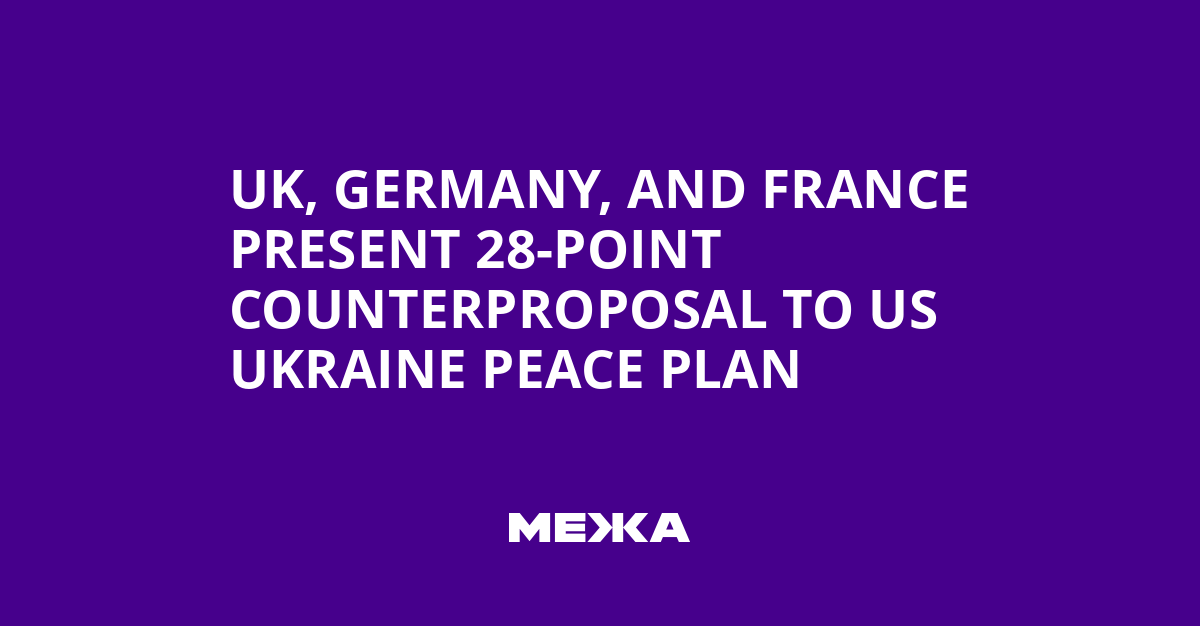As Ukrinform reports, the full text of the proposals was published by Reuters Reuters.
The United Kingdom, Germany, and France developed counter-proposals to the American 28-point peace plan, aimed at making it more acceptable to Ukraine. Reuters confirmed the publication of the full text of these proposals, citing a report from the Ukrainian information agency Ukrinform.
In the presented unofficial translation, the counter-proposals emphasize the main directions: reaffirmation of Ukraine’s sovereignty, ensuring security guarantees, engagement with NATO and the EU, as well as clear mechanisms for recovery and stabilization.
“The U.S. peace plan is a ‘wish list’ of the Russians, not an actual proposal from Washington.”
– Marco Rubio
The document stresses the need for open dialogue between Russia and NATO after the signing of the peace agreement, the establishment of a no-aggression framework between Ukraine and NATO member states, as well as clear definitions of security measures and avenues for de-escalation.
Among the key points are: reaffirmation of security for Ukraine, a cap on the size of the Ukrainian Armed Forces in peacetime, and consideration of possibilities for long-term integration into the European and transatlantic context.
It also mentions the deployment of allied forces in Poland and the U.S. security guarantees with corresponding conditions and financial mechanisms, as well as a recovery package and support for energy and infrastructure modernization, and measures for rebuilding cities and residential blocks.
The document outlines a framework agreement for restoring and reintegrating Russia into the global economy, including through joint projects in energy, infrastructure, and technology development, as well as the creation of joint security and legal-implementation working groups.
The text also considers the sanctions regime, the United States’ role in coordinating actions, and questions about Russia’s future participation in global formats of cooperation, with a potential return to global economic structures.
Additionally, the summary of the counter-proposal outlines prospects for Ukraine’s post-war reconstruction: funding, use of frozen Russian assets, and measures to protect human rights, religious tolerance, and protection of language minorities.
Below is a detailed list of the 28 main points of the counter-proposal:
- Affirmation of Ukraine’s sovereignty.
- The conclusion of a full and comprehensive non-aggression treaty among Russia, Ukraine, and NATO; resolution of disputes of the last 30 years.
- Elimination from the U.S. plan of the clause concerning Russia’s unreliability of intervention and NATO limits.
- After signing the peace agreement – initiate dialogue between Russia and NATO to address security issues and de-escalation.
- Ukraine receives reliable security guarantees.
- The size of the Ukrainian Armed Forces in peacetime – capped at 800,000.
- Ukraine’s accession to NATO – dependent on consensus among NATO members; alternatives to membership may be considered.
- NATO does not permanently deploy troops under its command in Ukraine in peacetime.
- NATO fighter jets stationed in Poland.
- U.S. security guarantees for Ukraine with the corresponding conditions and financial mechanisms.
- Ukraine has the right to EU membership and gains short-term access to the European market during the review process.
- A robust global package of recovery measures for Ukraine, including a development fund, infrastructure and technological projects, and joint projects in energy.
- Russia’s reintegration into the global economy with phased sanctions relief and long-term economic cooperation; Russia is invited to return to the G8.
- Ukraine will receive full reconstruction support and financial compensation; frozen Russian assets will remain until compensation for damages is paid.
- Establishment of a joint security working group with the participation of the United States, Ukraine, Russia, and European countries.
- Legislative codification of Russia’s no-aggression policy toward Europe and Ukraine.
- Continuation of the non-proliferation and nuclear arms control treaties.
- Ukraine commits to remaining a non-nuclear state.
- The Zaporizhzhia NPP operates under IAEA supervision; the produced energy is distributed equally between Russia and Ukraine (50:50).
- Ukraine adopts EU rules on religious tolerance and protection of linguistic minorities.
- Territorial arrangements: Ukraine will not restore occupied territories by force; land exchanges will begin from the line of contact; discussions depend on a ceasefire.
- After agreeing on territorial arrangements, both sides commit not to violate them by force; security guarantees do not apply in case of violation.
- Russia will not hinder the use of the Dnieper for commercial purposes; concluding agreements on free grain transport via the Black Sea.
- Creation of a humanitarian committee to resolve outstanding issues: exchange of prisoners and bodies, return of civilians and hostages, family reunification program.
- Ukraine conducts elections as soon as possible after the signing of the peace agreement.
- Measures to ease the suffering of conflict victims; rejection of automatic full amnesty.
- Legal enforceability of the agreement; oversight and guarantees by the Peace Council chaired by Donald J. Trump; sanctions for violations.
- Once a ceasefire is agreed, it comes into force immediately after the parties retreat to the agreed points, with monitoring under U.S. supervision.
According to Ukrinform, American media were discussing secret consultations with Russia regarding a new peace plan. According to Axios, the plan reportedly consists of 28 points, categorized into: peace in Ukraine, security guarantees, European security, and future U.S.-Russia-Ukraine relations. It was also mentioned that Kyiv would have to relinquish the controlled areas of Donbas and reduce the army; part of the territory was to be exchanged for security guarantees. Later, Marco Rubio described the peace plan as a ‘wish list’ and then repudiated this claim.
